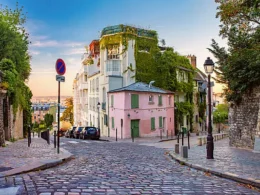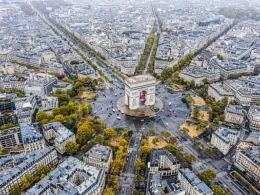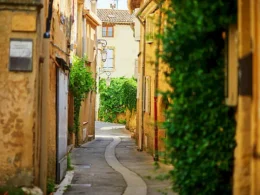‘The Evolution of French Art: A Museum Journey‘ offers a comprehensive exploration of the rich artistic heritage of France.
The exhibition navigates through significant periods, from the elaborate Baroque and Rococo era to the revolutionary movements of Impressionism and Post-Impressionism.
It also delves into the classical elegance housed within the Louvre and the avant-garde wonders exhibited at the Musée d’Orsay.
This museum journey provides a nuanced understanding of the evolution of French art, showcasing the diverse styles, techniques, and influences that have shaped the country’s artistic landscape.
Visitors can expect to immerse themselves in a captivating narrative of artistic progression, from the traditional to the experimental, as they traverse through the carefully curated displays.
The Baroque and Rococo Era
During the Baroque and Rococo era, French art experienced a significant shift in style and technique, marked by an emphasis on grandeur and ornate decoration. Ornate opulence and decorative extravagance became hallmarks of this period, reflecting the lavish and luxurious tastes of the French aristocracy.
In Baroque art, there was a focus on dramatic use of light and shadow, creating a sense of dynamism and theatricality in paintings and sculptures. This was later refined in the Rococo period, where the emphasis shifted towards intricate patterns, pastel colors, and whimsical themes.
The opulent and extravagant artistic expressions of this era were often commissioned for palaces, reflecting the luxurious lifestyles of the nobility. This shift in style not only influenced visual arts but also extended to architecture, interior design, and decorative arts, leaving a lasting impact on French cultural heritage.
Impressionism and Post-Impressionism
As pivotal movements in French art history, Impressionism and Post-Impressionism revolutionized artistic expression and challenged traditional techniques. They marked a significant shift away from the realistic depictions of previous eras, emphasizing the use of color theory and the artist’s interpretation of their subjects.
Impressionist painters, like Claude Monet and Pierre-Auguste Renoir, sought to capture the fleeting effects of light and color through loose brushwork and a focus on outdoor scenes.
Post-Impressionists, such as Vincent van Gogh and Paul Cézanne, further pushed the boundaries of artistic representation, experimenting with geometric forms and expressive use of color.
This artistic revolution not only transformed the way artists approached their work but also influenced subsequent movements, leaving an indelible mark on the evolution of French art.
Classical Elegance of the Louvre
The Classical elegance of the Louvre embodies the rich artistic heritage that evolved from the revolutionary movements of Impressionism and Post-Impressionism in French art history.
As one of the world’s largest and most visited museums, the Louvre’s grandeur is matched only by the timeless masterpieces it houses. The museum’s collection of classical art, including iconic works such as the Venus de Milo and the Winged Victory of Samothrace, reflects the enduring influence of classical aesthetics on French art.
The Louvre’s architecture, with its majestic courtyards and palatial galleries, provides a fitting backdrop for the classical elegance of its collections. This setting allows visitors to immerse themselves in the splendor of French art history, experiencing firsthand the refinement and sophistication that define the classical tradition.
Avant-Garde Wonders of the Musée D’orsay
In the vibrant landscape of French art history, the Musée D’orsay stands as a testament to the avant-garde movements that built upon the classical elegance of the Louvre, embodying the innovative and boundary-pushing spirit of the era. The museum’s avant-garde wonders showcase the daring and experimental nature of the late 19th and early 20th centuries, where artists sought to challenge traditional artistic norms and explore new forms of expression.
- Impressionist Masterpieces: The museum houses an exceptional collection of Impressionist works, capturing the essence of artistic innovation and revolutionary techniques.
- Post-Impressionist Treasures: From Van Gogh’s swirling brushstrokes to Cézanne’s geometric explorations, the museum’s collection exemplifies avant-garde experimentation.
- Art Nouveau Marvels: The ornate and intricate designs of Art Nouveau artists reflect a departure from traditional aesthetics, signaling a shift towards modernity.
- Symbolist Gems: Symbolist artworks provoke thought and emotion, representing a departure from realism and a foray into the abstract and the subconscious.
Frequently Asked Questions
What Are Some Lesser-Known Artists From the Baroque and Rococo Era Who Made Significant Contributions to French Art?
Many lesser-known female artists from the Baroque and Rococo era made significant contributions to French art. Among these regional artists, their influence on the development of French art during this period cannot be overstated.
How Did the Political and Social Climate of France Influence the Impressionist and Post-Impressionist Movements?
The political and social climate of France played a pivotal role in shaping the impressionist and post-impressionist movements. Cultural changes, including industrialization and urbanization, influenced artists to explore new techniques and subject matter, reflecting the evolving society.
Can You Provide More Information About the Restoration and Preservation Efforts for the Classical Art Pieces at the Louvre?
Restoration techniques and conservation efforts at the Louvre exhibit a meticulous approach to preserving classical art pieces. The museum employs advanced scientific methods, including chemical analysis and digital imaging, to ensure the longevity and integrity of these invaluable artworks.
What Are Some Avant-Garde Artists and Movements That Are Not as Well-Known as Others at the Musée D’orsay?
Exploring forgotten avant-garde artists and rediscovering overlooked movements at Musée d’Orsay sheds light on underappreciated innovators. Uncovering hidden artistic gems allows for a deeper understanding of the diverse and dynamic landscape of French art history.
Are There Any Controversies or Debates Surrounding the Interpretation of Certain Artworks at These Museums?
Controversial interpretations and artistic debates often surround certain artworks in museums such as the musée d’orsay. These debates stem from differing perspectives on the historical, cultural, and social contexts of the art, contributing to ongoing scholarly discourse.










